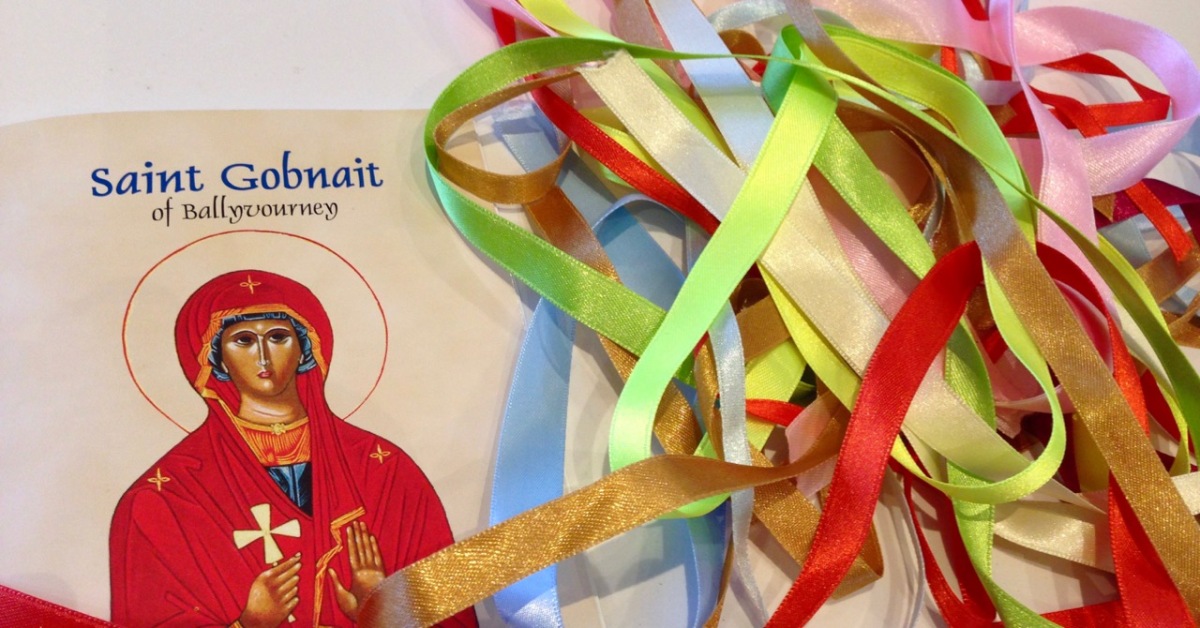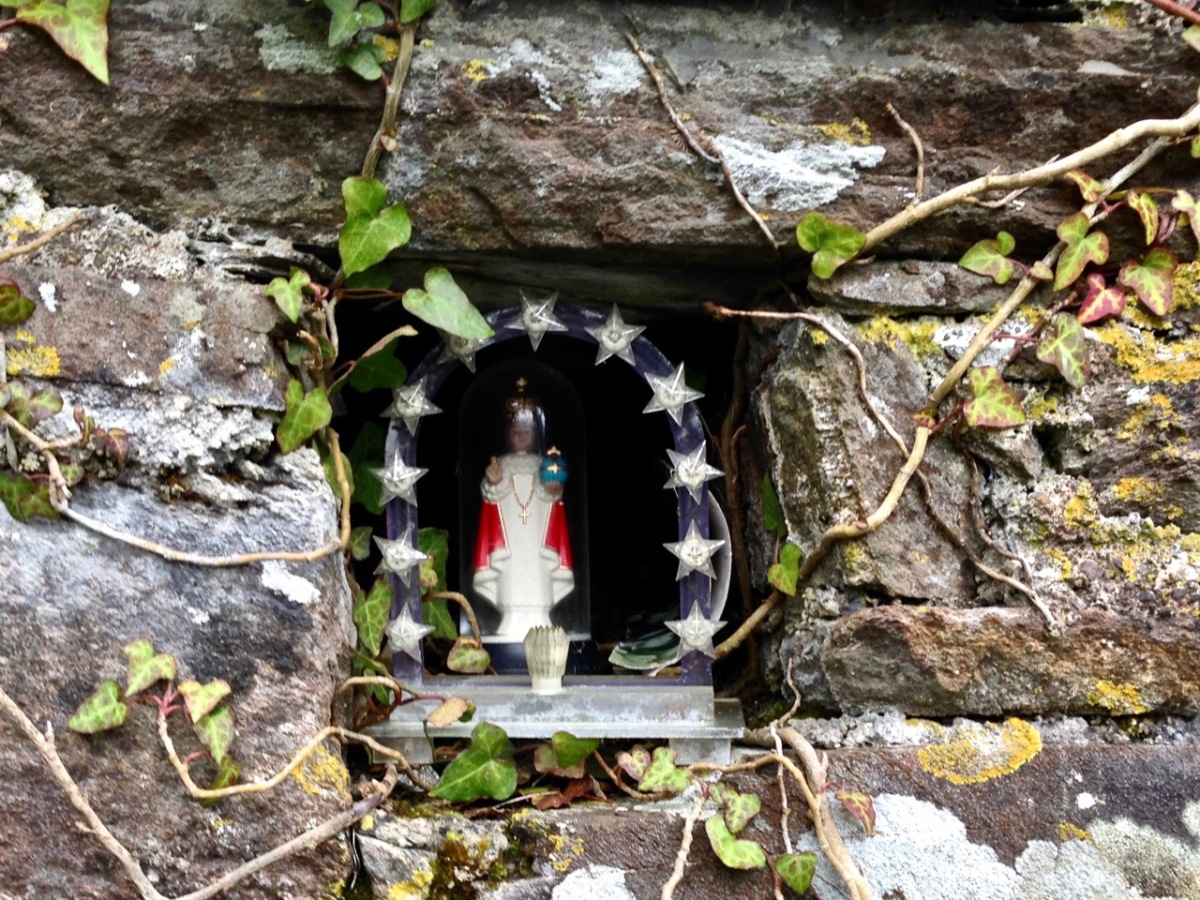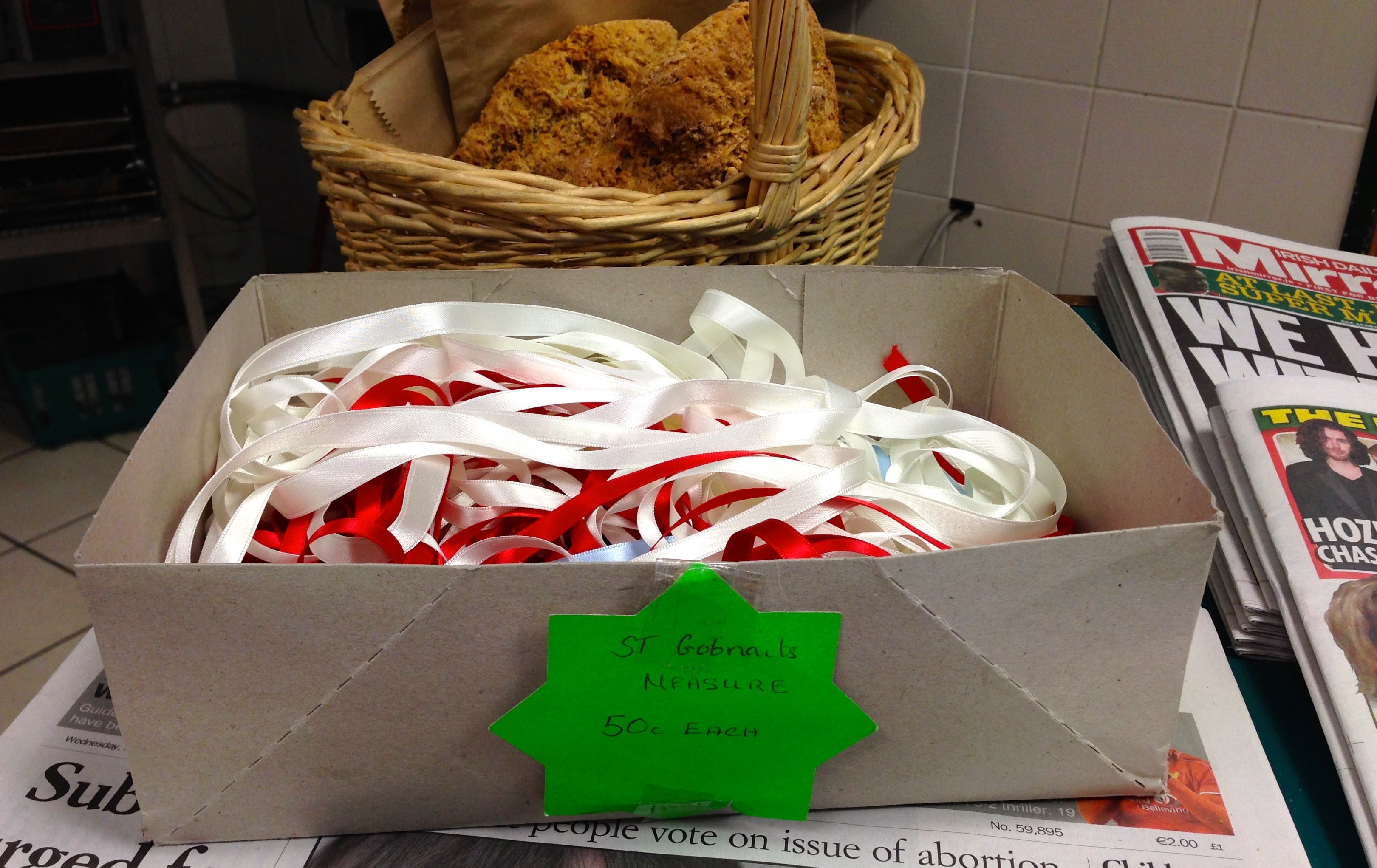We stood still and listened: the air was filled with humming – Bees swarming in February? But no… it was the murmuring of the pilgrims saying the decades of the Rosary by the grave of St Gobnait…*

We travelled up into the Muskerry Gaeltacht on Wednesday – 11 February: the Feast Day of Saint Gobnait. It’s a fair journey, and we felt that we had really gone into another world: we crossed over the Mountain of the Fairy – that’s my interpretation of the Shehy Mountains (Shee is Fairy) – others say the Irish Cnoic na Síofra means ‘hills of the animal hides’. For the first time in my life somebody – a passer by – addressed me in Irish… “An bhfuil hata agat le spáráil?” they said – “Have you got a hat to spare?” (I think it was a wry comment about the headgear I was wearing on the day).
Our goal was Saint Gobnait’s Church in Ballyvourney, where the Mass was to be heard celebrated in Irish. Also, we wanted to see the 13th century wooden statue which is brought in to the church on this day. When we arrived there was already a queue to buy ribbons and ‘measure’ them against the statue. In fact, it was quite an intricate ritual: first you wrapped your ribbons around the neck of the statue, then around the feet. Some did the same around the stomach – others passed the ribbons under the body of the statue and rubbed them along the surface. Many people kissed the statue and some picked it up and made the sign of the cross with it. We joined in and came away with a clutch of ribbons, now blessed by Saint Gobnait and imbued with health-giving and good-fortune-bringing properties.
The church was completely full for the Mass (it was also broadcast outside), which was celebrated by two Priests and a very robust men’s choir – beautiful singing in Irish. It was an uplifting experience, even though I hardly understood a word. A friendly atmosphere imbued all who were there, and excitement was in the air. Afterwards, we visited the statue again and then headed for Saint Gobnait’s Holy Well, her grave and the ruins of her ancient church, where the ‘Rounds’ were being performed all day. That’s when we heard the humming – it should have been Bees: this Saint has always been associated with them, and her statue which overlooks the pilgrimage site (and which was carved by Seamus Murphy in 1950) is decorated with Bees and with a Deer. This is also part of her story: when she was travelling through Ireland looking for a site to establish her community she was told she must continue on her way until she met with nine white Deer. She found them in Ballyvourney and that’s why in our time the little settlement flourishes on this February day.

We heard that there is another Holy Well, hidden in the woods just outside the town and seldom visited. This is known as Tobar Abán – Saint Abban’s Well. That saint seems to be closely associated with Saint Gobnait although not much is known about the lives of either of them – they lived back in the sixth century.
A visit to the Post Office provided us with the information we needed to get to this intriguing sacred site: walk over the bridge, go into the fields and look for a lone oak tree on the distant boundary – this marks the point where a trackway leads up through the woods. We made our way across a muddy pasture; the oak tree was prominent enough, and the track – but once inside the wood everything was quite densely overgrown. We would never have found it without the instructions, but we also had the help of red and white ribbons tied to trees and posts in strategic places – they had been there for some time: we wondered who set them up?
Tobar Abán is a wonderful site – a lonely outpost of religious sanctity but, for me, probably the most beautiful of all the holy places I have visited in Ireland so far. It’s an unexpected find: set away from everything, deep in an ancient oak wood, silent, still – one could imagine that it has always been like this, passing through generations of turbulent history and yet untroubled by it. Archaeologically it appears to be a cist with a cairn of stones built around it: this would imply pre-Christian origins. The lid of the cist (a burial chamber or repository for bones) is not visible – possibly it is under the large ballaun stone which rests on top. Above this is a small, relatively modern concrete cross embellished with offerings, beads and ribbons: other icons and objects are scattered around the site. The whole mound has a boundary defined by three standing stones, one of which is inscribed with ogham. Everything is covered in a layer of moss which seemed to exude a luminescence in the moist shade of the wood.
Saint Abban (or Abbán moccu Corbmaic) seems to have been active in many parts of Ireland, and tradition has it that he lived for three hundred years. The stories that are important here are the ones that link him with Saint Gobnait. It has been said that he founded a monastery in Ballyvourney before she arrived, and that he was her mentor and gave the foundation to her. Some say that Abban and Gobnait were brother and sister. Most important, perhaps, is the tradition that Abban had a cell or church just outside Ballyvourney and that he was buried in that cell when he died in 520. Could it be his grave that we found?
Saint Abban’s Well is a little distance from the cist, and is quite unassuming, especially compared to the elaborate wells around Saint Gobnait’s old church. It is merely an opening in a rock set in the ground: an old tray covers it and keeps the leaves out, and a wooden box beside it contains some cups and plastic bottles for collecting the water.
As we were making our way back across the fields we were surprised to see a lady in a red coat walking with a stick towards us. “Did you find it?” she asked. We assured her we had found the well and the shrine. “And did you see his bones?” she continued, “Last time I was there I lifted up the lid and saw the Saint’s bones inside…” We watched her go off towards the woods; when I looked back again she had disappeared.
There’s so much about the day: the journey across the Mountain of the Fairy; the Irish Mass and the ritual of the ribbons involving a 13th century wooden figure; the Rounds and the humming of the Saint’s Bees; the magical shrine in the woods – and I really do wonder about that lady in the red coat…
* Originally titled A Murmuration, this post has been re-edited. Although published under Finola’s name this time around, the post and the re-editing are by Robert..











The Lady in a red coat is interesting. Daphne D. C. Pochin Mould mentions, “some rubbed bones kept in a tin box and used for cures” at the grave of Abban. I wonder is this what the lady was alluding to?
LikeLike
Yes, that’s exactly what she was talking about. Here’s more information, including the comments – https://holywellscorkandkerry.com/2016/02/13/tobar-abban-ballyvourney/
LikeLike
Robert & Finola, it’s uncanny that I only discovered your wonderful journal a week ago and responded to your blog on Castle Island, where my Father’s family were from. Today I find your beautiful piece on St Gobnait and Ballyvourney where my Mother was born and bred. Mum passed away a few months ago but would have loved this. I’ll share it with my family. Thank you, Christine Barry (Leahy)
LikeLiked by 1 person
Christine – how wonderful to have those direct West Cork connections!
LikeLike
I came across devotion to St Gobnait when I was in Dun Chaoin in 2004, the people rose early to visit a well I think. I found this piece now..
“The main centres of devotion to Gobnait are Inis Oírr (Aran Islands), Dún Chaoin in West Kerry and Baile Bhúirne near the Cork / Kerry border. And there are a number of other places which carry her name – often as Kilgobnet or Cill Ghobnait – e.g. near Dungarvan.”
https://www.dioceseofkerry.ie/our-diocese/genealogy/saints/st-gobnait/
LikeLike
These were some really lovely places, Finola, to one under ” house arrest ” since last March. Cannot even go to see the sea. Loved the little wood, it would be great to have more of them. Also my g g g grandmother was named Gobnet, but she was from over the border in Kerry.
LikeLiked by 1 person
We are so fortunate to have the sea right outside our door – it’s been pretty wild these last few days! Robert
LikeLike
I came across devotion to St Gobnait when I was in Dun Chaoin in 2004, the people rose early to visit a well I think. I found this piece now..
“The main centres of devotion to Gobnait are Inis Oírr (Aran Islands), Dún Chaoin in West Kerry and Baile Bhúirne near the Cork / Kerry border. And there are a number of other places which carry her name – often as Kilgobnet or Cill Ghobnait – e.g. near Dungarvan.”
https://www.dioceseofkerry.ie/our-diocese/genealogy/saints/st-gobnait/
LikeLike
Love this
LikeLiked by 1 person
Thank you – it’s a re-run of a post I did a few years ago, because of ‘the day that’s in it’… Robert
LikeLike
Finola another brilliant post.We look forward to retracing your steps when lockdown ends!, Many thanks once again to you and your colleagues
Best wishes Donal Mangan
LikeLiked by 1 person
Thank you Donal. When will that be? (The post was mine – Robert’s – but a technical issue attributed it to Finola).
LikeLike
Thanks Robert, Still a great post !,! Last week I had hopes that it might have been around St Patrick’s day. This week it looks like Easter is more likely. I suppose the correct answer at this stage is “that is a good question “. The lockdown will end when it ends
Best wishes Donal
LikeLiked by 1 person
Reading of such customs and rituals make me ponder on society’s development. I wonder if we are still very basic beings, very close to myth, legend and superstition and I wonder of our modern sophistication is merely a veneer.
We have a Kilgobnet, close to Dungarvan, Co. Waterford but I have never heard of any particular devotions associated with the saint.
LikeLiked by 1 person
Her day is usually marked in the places where her name is known: there are several sites around the country.
LikeLiked by 1 person
Fascinating, Finola, a big leap from that time to now. Written with mystical intrigue!
We would like welcome you to visit the very bottom of our garden in Goleen, when safe , to see if we do have cilins as we think we may. After another stroll up Knocknaphuca?!
LikeLiked by 1 person
Certainly, Patricia. It’s me (Robert) responding as I wrote the post originally. Finola republished it. Best wishes…
LikeLike
Great post I trust you have sent it to the new RSAI Pres, Kelly Fitzgerald, “Head of Irish Folklore & Ethnology in the School of Irish, Celtic Studies and Folklore, UCD.” P x
On Thu, 11 Feb 2021 at 13:30, Roaringwater Journal wrote:
> Finola posted: ” We stood still and listened: the air was filled with > humming – Bees swarming in February? But no… it was the murmuring of the > pilgrims saying the decades of the Rosary by the grave of St Gobnait…* > Making the Rounds at Saint Gobnait’s Shrine on the” >
LikeLiked by 1 person
Thank you, Paul. No, we haven’t connected with Kelly Fitzgerald – we should. Robert.
LikeLike
What a delightful bonus during lockdown–St Abban’s Well and St Gobnait’s ribbons. Thanks a million!
LikeLiked by 1 person
Thank you, Kay. Hope you are well and flourishing. Robert
LikeLike